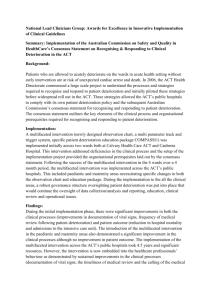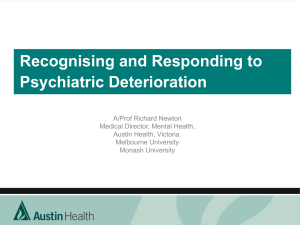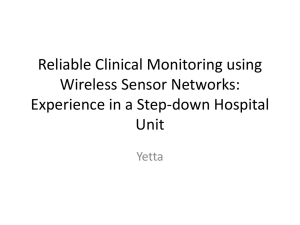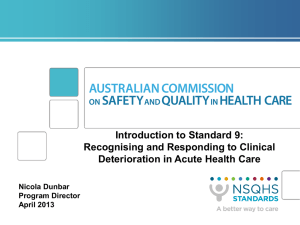Training-and-competencies-for-recognising-and-responding-to
advertisement
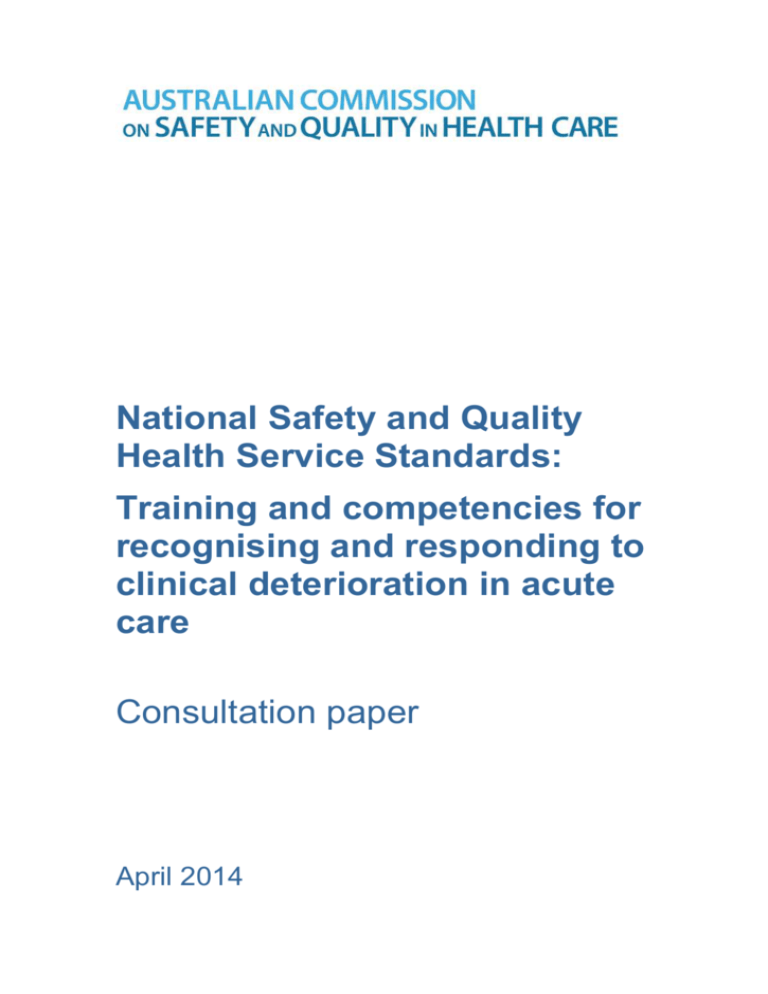
National Safety and Quality Health Service Standards: Training and competencies for recognising and responding to clinical deterioration in acute care Consultation paper April 2014 1 INTRODUCTION The National Safety and Quality Health Service (NSQHS) Standards were developed by the Australian Commission on Safety and Quality in Health Care (the Commission) with consumers, clinicians, technical experts and policy makers. The purpose of the NSQHS Standards is to reduce harm to patients, improve quality of care and provide a mechanism for the consistent application of accreditation across the health system. Assessment to the NSQHS Standards tests that systems are in place to ensure that minimum safety and quality requirements are met. From 1 January 2013 all public and private hospitals need to be assessed to the NSQHS Standards if they are to provide health services to the public. There are ten NSQHS Standards, including Standard 9: Recognising and Responding to Clinical Deterioration in Acute Health Care (Standard 9).1 Standard 9 describes the systems and processes that are required to respond effectively to patients when their clinical condition deteriorates. The intent of the standard is to ensure that a patient whose condition is deteriorating is recognised promptly, and appropriate action is taken. Criteria within Standard 9 relate to: establishing organisation-wide systems for recognising and responding to clinical deterioration recognising clinical deterioration and escalating care providing appropriate and timely care to patients whose condition is deteriorating communicating with patients and carers. One of the actions in Standard 9 relates to the skills and training clinicians should have to enable them to provide appropriate care to patients whose condition is deteriorating. Action 9.6.1 requires that ‘the clinical workforce is trained and proficient in basic life support’. During 2013 the Commission received feedback about Action 9.6.1, including questions about which clinicians needed training in basic life support and whether training in basic life support ensured adequate competency in the skills required to recognise, escalate and respond to clinical deterioration. Based on this feedback, the Commission is seeking advice about identifying the minimum requirements for core common competencies and training for recognising and responding to clinical deterioration in acute care, particularly with regard to the requirements of the NSQHS Standards. The purpose of this paper is to inform a consultation process with key individuals and organisations about minimum requirements for competencies and training for recognising and responding to clinical deterioration in acute care. It provides an overview of key safety and quality issues and current approaches to training. The consultation questions of interest to the Commission and the process for providing a submission are on page 12 of this paper. Please note that where the term ‘clinician’ is used in this paper, it refers to doctors, nurses and allied health professionals who provide direct patient care. 1 2 BACKGROUND The Commission describes the Australian approach to recognising and responding to clinical deterioration in acute care in two key documents. These are the National Consensus Statement: Essential Elements for Recognising and Responding to Clinical Deterioration (the Consensus Statement) and NSQHS Standard 9. Brief background information about these documents is provided below. Both documents are available for download from the Commission’s website. The Consensus Statement: http://www.safetyandquality.gov.au/our-work/recognition-and-responseto-clinical-deterioration/the-national-consensus-statement/ The NSQHS Standards: http://www.safetyandquality.gov.au/wp-content/uploads/2011/01/NSQHSStandards-Sept2011.pdf 2.1 National Consensus Statement The national framework for recognising and responding to clinical deterioration in Australia is described in the Consensus Statement. The Consensus Statement was developed by the Commission and endorsed by Health Ministers in 2010. Eight elements were identified in the Consensus Statement as being necessary for prompt and reliable recognition of, and response to clinical deterioration in acute care facilities. These eight elements are: 1. Measurement and documentation of observations 2. Escalation of care 3. Rapid response systems 4. Clinical communication 5. Organisational supports 6. Education 7. Evaluation, audit and feedback 8. Technological systems and supports. 2 2.2 Development of NSQHS Standard Action 9.6.1 Standard 9 is broadly based on the Consensus Statement, and includes a requirement that policies, procedures and protocols consistent with the Consensus Statement are put in place (Item 9.1). Early versions of Standard 9 did not include specific requirements about what training or competencies clinicians should have for recognising and responding to clinical deterioration in acute care. Feedback from a consultation process that was conducted for the draft NSQHS Standards in 2010 suggested that the education and training requirements should be strengthened. Advice on this issue was provided by the Commission’s Advisory Committee for the Recognising and Responding to Clinical Deterioration Program, which is made up of a health consumer, policy makers, clinicians, and medical and nursing academics from across Australia. Following these discussions, Standard 9 was amended to state that the clinical workforce should be trained and proficient in basic life support. The Australian Resuscitation Council definition of basic life support is used in Standard 9: ‘the preservation of life by the initial establishment of, and/or maintenance of, airway, breathing, circulation and related emergency care, including use of an automated external defibrillator’.1 3 3 EDUCATION AND TRAINING FOR RECOGNISING AND RESPONDING TO CLINICAL DETERIORATION: A SAFETY AND QUALITY ISSUE One of the fundamental components of successful recognition and response systems is that all clinicians who provide acute patient care have the necessary skills and knowledge to keep patients who deteriorate safe from preventable harm. It is necessary to ensure that clinicians can accurately assess patients and interpret signs and symptoms of clinical deterioration; recognise the urgency of a situation; communicate to escalate care effectively; and provide immediate interventions while awaiting expert help. When clinicians lack the requisite skills to identify and interpret signs and symptoms of clinical deterioration and initiate early interventions, patients may not receive appropriate and timely treatment. Serious adverse outcomes such as unplanned transfer to intensive care and cardiopulmonary arrest can result.2-5 There is evidence that there are significant gaps in trainee doctors’ and nurses’ preparation for recognising and managing patients who are clinically deteriorating, and that even experienced clinicians can have significant gaps in the necessary skills and knowledge.5-13 In an English study, senior doctors were asked to rate the preparedness of first year doctors for practice. In eight of the eleven topic areas assessed, the first year doctors were considered to be poorly prepared for starting work, especially in relation to clinical and practical skills.11 In a recent Australian study, undergraduate nurses in their final year of study were assessed in high fidelity simulated scenarios involving deteriorating patients. The authors of the study reported that ‘student teams engaged in 97 simulation experiences across the three scenarios and achieved a level of clinical performance consistent with the experts' identified pass level point in only 9 (1%) of the simulation experiences’.12 A 2007 review of the international literature concluded that the training of health professionals in acute care skills was suboptimal.9 Failures to adequately monitor and interpret patients’ vital signs contribute to delayed recognition of deterioration14-17 and there is evidence that patients continue to experience delays in escalation of their care, even when rapid response systems are in place.5 18-21 There is also evidence that patients who acutely deteriorate in hospital wards may experience sub-optimal management of their airway, breathing, circulation, monitoring and oxygen therapy.2 4 5 22 This can contribute to increased mortality and morbidity.2 20 23 Although considerable efforts have been made to address these issues through the efforts of jurisdictional and individual health services and the introduction of a consistent national approach to recognising and responding to clinical deterioration in acute care, episodes of sub-optimal management of clinical deterioration continue to occur. Failing Health: A Spotlight Report on Complaints about Clinical Deterioration in Queensland Hospitals was published by the Queensland Health Quality and Complaints Commission in 2013. There were 172 reviewed complaints and 205 root cause analysis reports analysed in the report. Failures to recognise deterioration 4 were identified as an issue in 81% of cases. Failures to respond adequately were identified in 46% of cases, and failures to communicate about deterioration in 38%.24 Two reports from the National Health Service (NHS) in England also highlight issues with the implementation of early warning and rapid response processes and protocols. A report into the quality of care at 14 NHS trusts found that the implementation of systems and processes can be unreliable partly because of gaps in the knowledge of staff.14 A retrospective review of in-hospital cardiac arrest cases identified significant gaps in the monitoring and interpretation of vital signs, inadequate supervision of junior doctors, episodes where clinicians failed to appreciate the urgency of the situation, and failures to escalate care during the prearrest period.5 Educating and training clinicians in the essential skills for recognising and responding to clinical deterioration is a necessary task for the delivery of safe care. Current approaches to education and training are briefly outlined in Section 5 of this paper. 5 4 ORGANISATIONS INVOLVED IN EDUCATING CLINICIANS The landscape for educating clinicians at undergraduate, postgraduate and professional levels in Australia is complex. There are a range of organisations that play a critical role in determining what skills and training are necessary to recognise and respond to clinical deterioration in acute care and how competence should be achieved, determined and maintained. Table 1 provides examples of some key organisations involved in clinical education and training. Table 1: Providers and agencies involved in education and training Examples of education providers Examples of agencies that can influence education and training Undergraduate Universities Colleges of technical and further education (or equivalent) Teaching hospitals Postgraduate Universities Teaching hospitals Australian Nursing and Midwifery Accreditation Council Australian Medical Council Australian Health Practitioner Regulatory Authority Australian Skills Quality Authority Tertiary Education Quality and Standards Authority Industry Skills Council Community Services and Health Industry Skills Council Australian Medical Council Australian Nursing Federation Specialist colleges Continuing professional development Employer facilitated inservice training Externally provided conferences, seminars and workshops Specialist colleges Level of training Specialist colleges Australian Health Practitioner Regulatory Authority National Boards 6 5 APPROACHES TO EDUCATING CLINICIANS ABOUT CLINICAL DETERIORATION In the National Consensus Statement, Essential Element 6: Education, outlines a number of key tasks that all doctors and nurses should be able perform. These include, among other things: systematically assessing a patient understanding and interpreting abnormal physiological parameters and other abnormal observations initiating appropriate early interventions for patients who are deteriorating responding with life-sustaining measures in the event of severe or rapid deterioration, pending the arrival of emergency assistance. Currently there is no agreed approach about how best to provide training that meets these objectives or how to describe and assess the minimum standard for competence. Approaches to training and educating clinicians about clinical deterioration vary according to professional group and speciality, level of training and location. There appear to be few cases where there are clear and consistent requirements regarding the minimum level of competence that is required in order to provide safe and effective care to patients who deteriorate in acute settings. Some common approaches to training are discussed in this section. 5.1 Resuscitation training Resuscitation skills are generally taught to health professionals through courses in basic and advanced life support. These courses teach skills for the purpose of preserving or restoring life by the establishment of, and/or maintenance of, airway, breathing, circulation and associated emergency care.25 The Australian Resuscitation Council guidelines for basic life support recommend that, as a minimum, learning objectives for training must include:26 recognition of an emergency ability to call an emergency response provider competence in chest compressions and rescue breathing emotional preparation for the capability to act in an emergency. Nurses and allied health professionals are commonly required to undertake annual competency training days which include basic life support training. This is in accordance with the Australian Resuscitation Council recommendation that all those who are trained in cardiopulmonary resuscitation refresh their knowledge and skills at least annually.26 However, the effectiveness of this approach has been questioned. There is evidence that while knowledge is retained over time, practical resuscitation skills decay more quickly.27 An Australian review in 2013 concluded that there is little evidence to support the widespread requirement for annual resuscitation training for experienced critical care nurses.28 This review recommended a shift to maintenance of resuscitation skills, rather than completion of assessments. 7 Despite hospitals making significant investments in resuscitation training, and cardiac arrest teams, there has been little associated improvement in mortality rates over the last 40 years.29 Failures to improve mortality rates may in part be because when inhospital cardiopulmonary arrest occurs, it is often as the end point of failures to detect or adequately respond to a person’s clinical deterioration while it is potentially reversible.2 24 30 5.2 Interdisciplinary training courses Since the advent of formalised recognition and response systems, efforts have been made by acute care service providers to move the focus of training courses to earlier in the continuum of clinical deterioration. A number of interdisciplinary courses have been developed in Australia and internationally with the purpose of teaching postgraduate hospital-based clinicians the skills and knowledge required for more timely and effective recognition and response to clinical deterioration. The content of these courses generally includes: signs, symptoms and triggers for detecting deterioration systems for escalating care systematic, rapid, prioritised assessment and treatment of the person’s physical deterioration common causes of clinical deterioration such as sepsis and hypoglycaemia non-technical skills such as communication and teamwork when and how to call for expert help. Evaluation of the impact of these courses is limited, however there is some evidence that they contribute to the successful implementation of broader recognition and response programs. In an Australian study of the COMPASS program (which involved implementation of a training course, a track and trigger observation chart and a response system) significant reductions in unexpected intensive care admissions and in-hospital deaths were seen alongside improved vital sign documentation and increased numbers of medical reviews and medical emergency calls.31 In a study of the ALERT course (developed in the United Kingdom) the confidence levels of attending health professionals were improved.32 5.3 Undergraduate nurse and midwife training Before graduation, registered and enrolled nurses and midwives are required to meet the requirements of the relevant competency standard outlined by the Nursing and Midwifery Board of Australia.33 The standards outline a number of competencies that relate to recognising and responding to clinical deterioration. These include conducting clinical assessments, communicating effectively, and responding to emergencies. However, it appears that undergraduate nursing schools can interpret and assess these competencies quite differently. A survey of Australian undergraduate schools of nursing conducted by the Commission (report in draft) found varied approaches to teaching about acute deterioration and assessing students’ competence. Seventeen of a total of 37 nursing 8 schools responded to the survey (46% return rate). Eleven of the 17 responding schools require students to be certified in basic life support before graduation, and only 12 of the 17 require that students achieve a specific level of competence in identification, initial management, and escalation of care for patients suffering acute deterioration. Of those that do require a specific level of competence in these skills, the definition of ‘competence’ varies. Two of the responding schools reported defining competence against the Nursing and Midwifery Board of Australia competencies within the domain of Provision and Coordination of Care. Others defined competence in terms of achievement of a passing grade in specific courses or assessments. Competence was also reported to be assessed in range of ways. These included passing a series of observed case study simulations, assessment during clinical placements, achieving basic life support certification or undertaking online training modules. 5.4 Undergraduate medical training Since 2010, Medical Deans Australia and New Zealand (MDANZ) have been conducting a three stage competencies project to identify, describe and benchmark the competencies, diagnostic and procedural skills, and assessment standards for undergraduate medical education. In the Framework of Clinical Competencies for the medical graduate, a series of attributes for medical graduates are described.31 A number of these relate to recognising and responding to clinical deterioration. For example, medical graduates are expected to be able to recognise serious illness and perform common emergency and life-saving procedures, including caring for unconscious patients and providing cardiopulmonary resuscitation. Further attributes describe the expectations for communicating with patients, families, and interdisciplinary colleagues; performing accurate physical and mental state examinations; and interpreting diagnostic information, the history and physical examination findings to reach a differential diagnosis. 5.5 Specialist medical training courses Doctors’ postgraduate training has traditionally been shaped by the requirements of their professional colleges. Education and training about the detection of and response to clinical deterioration varies according to speciality. For example, trainee surgeons are required to complete the Care of the Critically Ill Surgical Patient course, and trainee anaesthetists must complete either the Effective Management of Anaesthetic Crises or Early Management of Severe Trauma course.34 35 These types of courses are generally completed once during training and maintenance of knowledge and skills over the course of a career in medicine is considered a matter for the individual practitioner. While professional colleges set requirements for continuing professional development, they do not generally specify the content or topics to be covered in this training. There are some exceptions; for example, the Royal Australian College of General Practitioners requires certification in cardiopulmonary resuscitation on a three yearly basis. 9 5.6 Competency frameworks There are a number of documents that describe what is required for members of the health workforce in Australia. These include profession-specific documents such as the Competency Standards for the Registered Nurse36 and the Australian Curriculum Framework for Junior Doctors,37 as well as more generally applicable documents such as the Health Workforce Australia National Common Health Capability Resource.38 While such documents include requirements that relate to the skills and knowledge needed to recognise and respond to clinical deterioration, they generally lack a specific focus on this area of competence. The National Patient Safety Education Framework39 was developed by the former Australian Council for Safety and Quality in Health Care (now the Commission) in 2005. It was designed to identify the skills, knowledge, behaviours, attitudes and performance required by all health workers in relation to patient safety. A number of learning objectives described in the framework relate to the skills needed to recognise and respond to clinical deterioration (for example, communication, working safely and managing risk) although they are not specifically written to apply in that context. The extent to which the framework has influenced clinical curricula in Australia is unclear as formal evaluation has not occurred. The Australian framework was used to help build the World Health Organisation (WHO) Patient Safety Curriculum for Medical Schools. The WHO curriculum includes 11 topics related to patient safety. It is largely focussed on teaching the theoretical underpinnings of patient safety rather than on the clinical skills required to provide safe patient care. In 2009, the United Kingdom’s National Health Service (NHS) released a framework of core competencies for responding to acutely ill patients in hospital.40 These identify the key skills and knowledge required by different care providers to respond to various clinical scenarios according to their role and responsibilities. In this framework basic life support training is recommended as a mandatory requirement for all hospital employees, including non-clinical staff. The competency framework has now been archived and there is no available information regarding evaluation of the implementation or impact of these competencies in practice. The NHS competency framework is available for download from: http://webarchive.nationalarchives.gov.uk/20130107105354/http://www.dh.gov.uk/en/ Publicationsandstatistics/Publications/PublicationsPolicyAndGuidance/DH_096989 10 6 WHAT TRAINING AND COMPETENCIES ARE NEEDED FOR RECOGNISING AND RESPONDING TO CLINICAL DETERIORATION IN ACUTE CARE? The intention of Standard 9 is to ensure that systems are in place to support the clinical workforce to recognise clinical deterioration and provide an appropriate and timely response. Action 9.6.1 stipulates that basic life support training is one of the mechanisms to ensure that the clinical workforce have the essential skills and training to achieve this. This is consistent with the traditional approach of annual resuscitation training for nurses and allied health staff, and with recommendations made by organisations such as the National Institute of Clinical Excellence in the United Kingdom. However, there is evidence that delayed or inadequate recognition of deterioration and/or escalation of care (commonly described as afferent limb failure) are the most commonly reported points of failure in recognition and response systems.2 18 24 While some professional groups, such as anaesthetists or intensive care physicians, will need training that far exceeds any minimum requirement, it seems reasonable that patients should be assured that any clinician providing patient care in an acute health service has achieved a minimum standard of competency in the skills required to recognise clinical deterioration, escalate care, and provide a timely and appropriate response while awaiting help from responders with advanced clinical skills. Currently there are varied approaches to providing training and education related to recognising and responding to clinical deterioration. There is a lack of clear and specific agreement, guidance or evidence about what knowledge is required as a minimum standard for all clinicians providing patient care, how it should be taught, and how competency should be assessed. To provide clarity in the requirements of the NSQHS Standards, and to ensure that patients are protected from harm, the Commission is seeking further information about the minimum standard that should be required for competence in the skills and knowledge required to provide safe care to patients who deteriorate in acute care settings. 11 7 THE CONSULTATION PROCESS The purpose of this consultation is to determine if there is a core set of skills, knowledge and competencies for recognising and responding to deterioration that should be common to all clinicians providing acute patient care. Given the lack of definitive evidence to guide the Commission in this matter, the views of healthcare providers, colleges, professional bodies, private hospital groups, jurisdictional clinical leads and other key stakeholders are being sought. Information from this consultation process will inform the Commission’s decision-making when reviewing Standard 9 in 2015. It will also aid the Commission to determine if there is a need for additional or alternative mechanisms to provide a standardised approach to training and a framework for accountability. The aim of this consultation process is to seek advice about: what core skills, knowledge and competencies are required for all clinicians providing acute patient care to recognise deterioration, escalate care and provide an initial response until expert help arrives how initial and ongoing competence should be assessed who should be required to undergo mandatory training in the core skills, knowledge and competencies related to recognising and responding to clinical deterioration in acute health facilities when, how and how often this training should occur what mechanisms are, or should be, in place to ensure that such training occurs, and that the skills, knowledge and competencies are maintained. Questions of particular interest to the Commission are as follows: 1. What core knowledge and skills does your organisation view as the minimum standard essential for competency in recognising and responding to clinical deterioration? 2. In your organisation (or for members of your organisation) what, if any, mandatory training is required in relation to the skills and knowledge for recognising and responding to clinical deterioration? 3. How is this training provided? 4. How is competency demonstrated and maintained? 5. Which clinicians should have at least the minimum standard of training and competence in the knowledge and skills for recognising and responding to clinical deterioration? 6. When, how, and how often, should this training occur? 7. Should repeated assessment of competence be required throughout a clinician’s career? If so, when, how and how often should competence be reassessed? If not, how should prior learning be assessed and recognised? Note that where the term ‘clinician’ is used in this paper, it refers to doctors, nurses and allied health professionals who provide direct patient care. 12 8. If your organisation considers that some clinicians should be exempt from such training and competency requirements, which clinicians should be exempt and what is the reason for exemption? 9. Should training for recognising and responding to clinical deterioration be mandated by the Commission in Standard 9, or are there other mechanisms to ensure that such training occurs and clinicians’ skills are maintained? Submissions do not have to address any or all of these questions and may respond to other issues raised in the consultation paper. All submissions are welcome and will be accepted until 27 June 2014. Submissions should be marked ‘Training and competency requirements for recognising and responding to clinical deterioration’ and forwarded to: Australian Commission on Safety and Quality in Health Care GPO Box 5480 Sydney NSW 2001 or emailed to rrconsultation@safetyandquality.gov.au. 13 REFERENCES 1. Australian Commission on Safety and Quality in Health Care. National Safety and Quality Health Service Standards. Sydney: ACSQHC, 2011. 2. Trinkle RM, Flabouris A. Documenting Rapid Response System afferent limb failure and associated patient outcomes. Resuscitation 2011;82:810-814. 3. Goldhill DR, White SA, Sumner A. Physiological values and procedures in the 24 hours before ICU admission from the ward. Anaesthesia 1999;54(6):529-534. 4. McQuillan P, Pilkington S, Allan A, Taylor B, Short A, Morgan G, et al. Confidential inquiry into quality of care before admission to intensive care. British Medical Journal 1998;316:1853-1858. 5. Findlay G, Shotton H, Kelly K, Mason M. Time to Intervene? A review of patients who underwent cardiopulmonary resuscitation as a result of an in-hospital cardiorespiratory arrest: National Confidential Enquiry into Patient Outcome and Death, 2012. 6. National Patient Safety Agency. Recognising and responding appropriately to early signs of deterioration in hospitalised patients: National Patient Safety Agency, 2007. 7. Garling P. Final report of the Special Commission of Inquiry: Acute Care Services in NSW Public Hospitals. Sydney: NSW Government, 2008. 8. Weingarten S, Lloyd L, Chiou C-F, Braunstein G. Do subspecialist working outside of their speciality provide less efficient and lower-quality care to hospitalized patients than do primary care physicians? Archives of Internal Medicine 2002;162(5):527-532. 9. Smith C, Perkins G, Bullock I, Bion J. Undergraduate training in the care of the acutely ill patient: A literature review. Intensive Care Medicine 2007;33:901907. 10. Buist M, Jarmolowski E, Burton P, McGrath B, Waxmnan B, Meek R. Can interns manage clinical instability in hospital patients? A survey of recent graduates. Focus on Health Professional Education: A Multi-Disciplinary journal 2001;13:20-28. 11. Matheson C, Matheson D. How well prepared are medical students for their first year as doctors? The views of consultants and specialist registrars in two teaching hospitals. Postgraduate Medical Journal 2009;85:582-589. 12. Bogossian F, Cooper S, Beauchamp A, Porter J, Kain V, Bucknall T, et al. Undergraduate nursing students' performance in recognising and responding to sudden patient deterioration in high psychological fidelity simulated environments: An Australian multi-centre study. Nurse Education Today 2013;13:S0260-6917. 13. Smith G, Poplett N. Knowledge of aspects of acute care in trainee doctors. Postgraduate Medical Journal 2002;78:335-338. 14. Keogh B. Review into the quality of care and treatment provided by 14 hospital trusts in England: overview report: NHS, 2013. 15. Endacott R, Kidd T, Chaboyer W, Edington J. Recognition and communication of patient deterioration in a regional hospital: A multi-methods study. Australian Critical Care 2007;20:100-105. 16. MERIT Study Investigators. Introduction of the medical emergency team (MET) system: a cluster-randomised controlled trial. Lancet 2005;365:2091-2097. 17. Van Leuvan C, Mitchell I. Missed opportunities? An observational study of vital sign measurements. Critical Care and Resuscitation 2008;10(2):111-115. 18. Tirkkonen J, Yla-Mattila J, Olkkola K, Huhtala H, Tenhunen J, Hoppu S. Factors associated with delayed activation of medical emergency team and excess mortality: An Utstein-style analysis. Resuscitation 2013;84:173-178. 19. Calzavacca P, Licari E, Tee A, Egi M, Downey A, Quach J, et al. The impact of rapid response system on delayed emergency team activation patient 14 characteristics and outcomes - A follow-up study. Resuscitation 2010;81(1):31-35. 20. Calzavacca P, Licari E, Tee A, Egi M, Haase M, Haase-Fielitz A, et al. A prospective study of factors influencing the outcome of patients after a Medical Emergency Team review. Intensive Care Medicine 2008;34(11):2112-2116. 21. Jones L, King L, Wilson C. A literature review: Factors that impact on nurses' effective use of the Medical Emergency Team (MET). Journal of Clinical Nursing 2009;18:3379-3390. 22. DeVita M, Hillman K, Bellomo R. Textbook of rapid response systems: concept and implementation. New York: Springer, 2011. 23. Boniatti MM, Azzolini N, Viana MV, Ribeiro BS, Coelho RS, Castilho RK, et al. Delayed Medical Emergency Team Calls and Associated Outcomes. Critical Care Medicine 2013. 24. Health and Quality Complaints Commission. Failing health: A spotlight report on clinical deterioration issues in Queensland hospitals. Brisbane, August, 2013. 25. Australian Resuscitation Council. Guideline 11.1 Introduction to Advanced Life Support: Australian Resuscitation Council, 2010. 26. Australian Resuscitation Council. Guideline 10.1 Basic Life Support Training: Australian Resuscitation Council, 2013. 27. Hamilton R. Nurses' knowledge and skill retention following cardiopulmonary resuscitation training: a review of the literature. Journal of Advanced Nursing 2005;51(3):288-297. 28. Allen J, Currey J, Considine J. Annual resuscitation competency assessments: A review of the evidence. Australian Critical Care 2013;13:12-17. 29. Safar P. On the history of modern resuscitation. Critical Care Medicine 1996;24(2 ):S3-11. 30. Schein RM, Hazday N, Pena M, Ruben BH, Sprung CL. Clinical antecedents to in-hospital cardiopulmonary arrest. Chest 1990;98(6):1388-1392. 31. Australian Commission on Safety and Quality in Health Care. Focus Group Transcript, 2010. 32. Featherstone P, Smith GB, Linnell M, Easton S, Osgood VM. Impact of a one-day inter-professional course (ALERTTM) on attitudes and confidence in managing critically ill adault patients. Resuscitation 2005;65:329-336. 33. Codes and Guidelines Competency Standards. Nursing and Midwifery Board of Australia, 2013. (Accessed 11 November, 2013, at http://www.nursingmidwiferyboard.gov.au/Codes-GuidelinesStatements/Codes-Guidelines.aspx#competencystandards.) 34. Care of the Critically Ill Surgical Patient (CCrISP). Royal Australasian College of Surgeons. (Accessed August 13, 2013, at http://www.surgeons.org/for-healthprofessionals/register-courses-events/skills-training-courses/ccrisp/.) 35. EMAC and EMST overview. Australian and New Zealand College of Anaesthetists. (Accessed August 13, 2013, at http://www.anzca.edu.au/training/emac-and-emst.) 36. Australian Nursing and Midwifery Council. National Competency Standards for the Registered Nurse, 2005. 37. Confederation of Postgraduate Medical Education Councils. Australian Curriculum Framework for Junior Doctors, 2012. 38. Health Workforce Australia. National Common Health Capability Resource: shared activities and behaviours in the Australian health workforce, 2012. 39. Australian Council for Safety and Quality in Health Care. National Patient Safety Education Framework. Canberra, 2005. 40. Department of Health. Competencies for recognising and responding to acutely ill patients in hospital: Department of Health, 2009. 15
